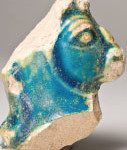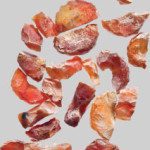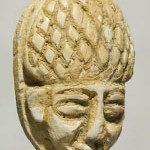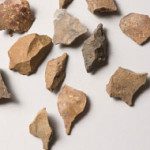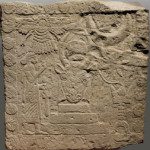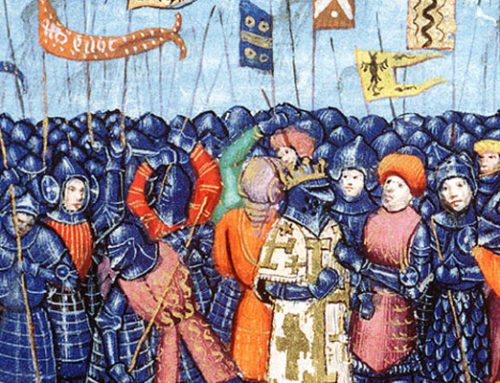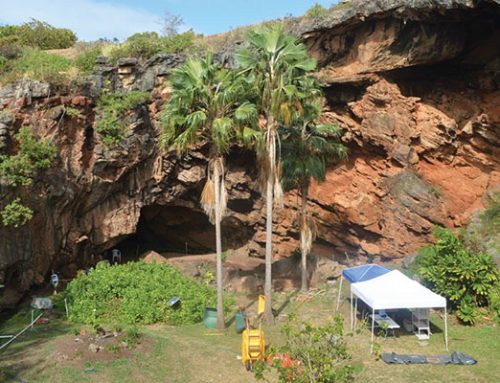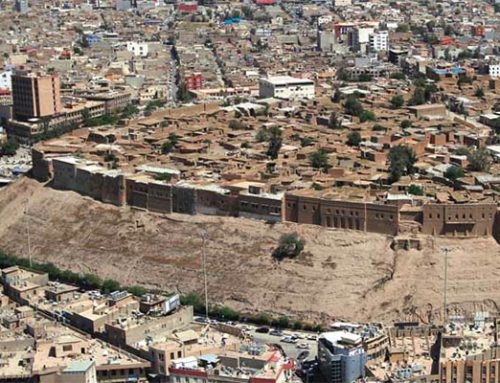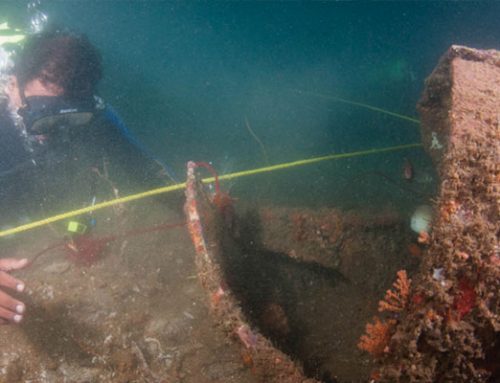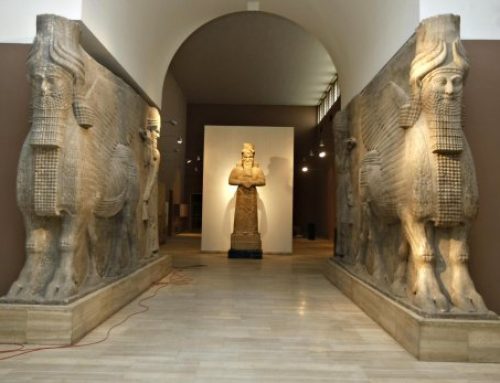In a remote corner of Saudi Arabia, a team has been excavating the remains of the ancient oasis of Tayma

At the site of Tayma, excavators work at an area outside what is thought to have been the settlement’s temple. A deep well now covered in wood (far right), may have been connected to it in antiquity.
In the harsh landscape between the stark Hijaz Mountains and the vast Nefud Desert in northwestern Saudi Arabia, the very existence of the town of Tayma hinges on a quirk of geology. This is one of the world’s driest places, receiving less than four inches of rain annually on average. Yet until about 6,000 years ago, when the climate turned from wet to arid, a saltwater lake a saltwater lake covered eight square miles on the northern fringe of what is now a lush oasis. While today that lake is a forbidding salt pan, or sabkha in Arabic, its ghost remains in the form of an aquifer that rises close to the surface on its southern edge. Even in the hottest and fiercest summers, when no precipitation falls and temperatures regularly top 115 degrees Fahrenheit, farmers here can depend on shallow wells for a seemingly endless flow of cool, fresh water for their luxuriant gardens and shady date palm plantations.

The Bir Hadaj, perhaps the oldest well on the Arabian Peninsula, has been in use for thousands of years and was recently restored under the leadership of Muhammad al-Najem and the Saudi Commission for Tourism and Antiquities.
This unceasing bounty in an inhospitable land made Tayma famous. For millennia, merchants and missionaries, kings and caravans, halted here to refresh themselves and their animals and to take on provisions for the hard journey through the desert to Egypt, the Mediterranean coast, Iraq, or Yemen. The settlement, also called Tema in ancient records, earns a passing mention in the Old Testament for its wells: “The inhabitants of the land of Tema brought water to him that was thirsty,” says the book of Isaiah, perhaps a reference to Bir Hadaj, the largest, most famous, and possibly oldest working well on the Arabian Peninsula, which sits in the middle of Tayma’s old town and still supplies water to some of its residents. Local lore places the well’s origin in the third millennium B.C., although there is no archaeological evidence to date it. Yet it must have been such wells that watered the gardens that made Tayma green year-round since before recorded history.
For some, Tayma may be best known as the temporary seat of power of one of the ancient world’s most enigmatic rulers. Cuneiform tablets and inscriptions record that, in the sixth century B.C., Babylon’s King Nabonidus left what was then the largest and wealthiest city on Earth for this obscure oasis. He returned home a decade later, only to lose his empire to the Persians, effectively ending 2,500 years of Mesopotamian civilization. Little else has been widely known about Tayma before or after Nabonidus’ ignominious end as a Persian captive. However, it has a surprisingly rich history, dating back more than 3,000 years
before the king’s arrival, which has captured the attention of a Saudi-German research team managed by the Saudi Commission for Tourism and Antiquities. Overseen by Ricardo Eichmann and directed by Arnulf Hausleiter, both of the German Archaeological Institute (DAI), with the support of the commission’s Tayma chief Muhammad al-Najem, in 2004 the team began the first comprehen-sive excavations at what has become the country’s largest archaeological site. Tayma’s main mound covers more than 200 acres, and is now fenced off from palm groves and the encroaching modern town.
Temples decorated with Egyptian statues, South Arabian inscriptions, and carvings with Mesopotamian motifs attest to Tayma’s cosmopolitan nature. Piped-in water once
splashed through one large sanctuary where it pooled in massive carved-stone troughs outside the doors, perhaps for ritual ablutions. Rock carvings from the area, dating at least to Nabonidus’ time, suggest that the people of Tayma were literate, wealthy, and well traveled. What the excavators are uncovering is reshaping not just our understanding of this remote location, but also how trade operated in the ancient Middle East, spreading ideas and beliefs as well as goods. “Tayma is an incredibly important site, and scholars are scarcely aware of its significance,” says Daniel Potts, a New York University archaeologist specializing in ancient Arabia, Mesopotamia, and Iran.

Called the “al-Hamra cube,” this sandstone pedestal or altar found at Tayma dates to the 5th or 4th century b.c. and depicts ritual scenes combining elements of local, Egyptian, and Mesopotamian artistic styles.
THE SABKHA ITSELF, just north of Bir Hadaj, is flat and featureless. But thousands of years ago, even as it dried up, it drew people to its salty shores. Over the past two field seasons, archaeologist Max Haibt from the Free University of Berlin has uncovered thousands of unfinished carnelian beads and hundreds of thousands of pieces of worked flint that, according to radiocarbon dating of charcoal associated with the stones, date back as early as 4000 B.C. In one trench measuring only three feet square and six inches deep, Haibt excavated 700 flint drills used to bore holes in the carnelian. Yet after surveying the area, he found only 10 finished beads made from the deep-red stone that was highly prized across the ancient Near East and Indian subcontinent. Haibt believes that large numbers of artisans were producing these exotic manufactured goods to sell elsewhere. Based on the shape of the beads and the quality of the carnelian, he suspects that the market in this era was pre-Dynastic Egypt, where large numbers of carnelian beads have been discovered in tombs. If he’s correct, it would provide evidence that Arabia and Egypt may have been linked by trade long before the rise of the Old Kingdom around 2700 B.C. That Tayma was part of an international trade network six millennia ago, producing luxury goods for export, is surprising. Although Jonathan Kenoyer, an archaeologist at the University of Wisconsin–Madison, is skeptical of Haibt’s theory, given that carnelian was worked in the fourth millennium B.C. at Egyptian sites such as Hierakonpolis, the sheer numbers of unfinished beads at Tayma impress him. “This may have been one of the big production centers that supplied the Arabian Peninsula, and probably also parts of Mesopotamia and the Levant, with carnelian beads,” Kenoyer says.
Aside from the scatter of beads, little is known about the early settlement. Hausleiter and his team explored the edges of the sabkha and found no architecture. They did, however, find remains of oat, millet, wheat, and barley cultivation dating from the third millennium B.C., as well as evidence of olives, grapes, and figs, all of which require irrigation. This suggests that Tayma was likely an established settlement centered on wells that provided life-giving water for farms. That may signal a need for a change in thinking, since most scholars have assumed that interior Arabia consisted mainly of small bands of herders and hunters until domestication of the camel after 1000 B.C.
Extending along the southern edge of the sabkha is Tayma’s most enduring and mysterious feature: a sandstone and mud-brick wall that runs an astonishing 11 miles, punctuated along the way with sturdy rectangular towers. The wall encloses more than 2,000 acres, and, in places, still stands as high as 25 feet. Celebrated in texts written by medieval Muslim travelers, it may have functioned as a defensive perimeter, a dam to prevent an incursion of saltwater from the sabkha during rare heavy rains, a corral for animals, or a combination of all three.
Historians and archaeologists had long thought that the wall, given its tremendous size and extent, was likely built dur-ing the time of Nabonidus, or perhaps even later. When Haus-leiter’s team sampled sediments at the foot of one section and used optically stimulated luminescence to determine how long it had been since the sun shone on the base, the results were wholly unexpected. Parts of the wall were created during the Bronze Age, between 2500 and 2000 B.C., during the heyday of Egypt’s Old Kingdom, Mesopotamian city-states such as Ur, and the distant Indus Valley civilization, according to Nicole Klasen from the University of Cologne. The towers, says Hausleiter, date to as early as 1900 B.C. “The new data from northern Arabia, particularly Tayma, fundamentally challenges this reconstruction of settlement history in this area,” adds Bryn Mawr College archaeologist Peter Magee. The dating indicates that Tayma—and possibly other Arabian oases—was a bustling, wealthy, and sophisticated town a thousand years earlier than scientists once suspected.
Yet the Saudi-German team has uncovered frustratingly little evidence of the people who lived at Tayma during this period. An ax and a ribbed dagger found in a modern industrial area by Saudi archaeologist Mahmoud al-Hajiri likely date to the time of the wall and tower construction, and have parallels in Syria and the Levant, but weren’t found in a datable context, and might have been brought there long after their production. On the south side of the mound, excavators did locate skeletons in graves from this era. The bones are badly deteriorated and have yet to yield much data, though the pot-tery in the graves suggests they come from the same time as the wall construction. Specialist Emmanuele Petiti of the DAI says that some arm bones show signs of continuous muscle stress, a hint that at least some of the townspeople engaged in repetitive physical labor. Petiti is hopeful that additional analyses will provide clues to this period when Tayma could brag of having one of the ancient world’s most extensive walls.

A mid-6th-
century b.c.
sandstone stela, showing
Babylon’s King Nabonidus, was found
in debris near one of Tayma’s main temples, a
further indication of the time the ruler spent at the oasis.
TAYMA’S TIES TO the outside world before and during the Bronze Age are intriguing but unclear. With the dawn of the Iron Age in the twelfth century B.C., however, the picture sharpens. In 2010, Saudi archaeologists found an inscription bearing the name of the Egyptian pharaoh Ramesses III (r. 1187–1156 B.C.) on a rock face outside Tayma, the first pharaonic inscription found in Saudi Arabia. It matches similar examples found on a trading route passing from the Nile across the Sinai and into what is now Jordan. Tayma by then was part of an organized long-distance network. A couple of centuries after Ramesses’ reign, the domesti-cated camel began to make large caravans across forbidding desert terrain possible. Frankincense that could only be produced in southern Arabia, in what is now Yemen and Oman, could be car-ried in large quantities to the temples of Egypt and Mesopotamia using well-watered Tayma with its protective walls as a stopping point.
Evidence shows that Tayma’s prosperity and interna-tional contact continued to increase between the twelfth and ninth centuries B.C. On the southwestern edge of the site, archaeologists found a building that Hausleiter believes was a temple. It measures 40 by 65 feet, with pilasters and a paved forecourt, all protected by a six-foot-thick wall. Within, they found the remains of bone, ivory, wood, and faience objects such as amulets, gaming pieces, and glazed vessels, as well as statues of Egyptian deities and a scarab with a human head, attesting to close relations with Egypt during and after the reign of Ramesses III.
Centuries later, the temple was covered by a cemetery of rock-cut graves that may provide some insight into the lives of Tayma’s residents in the Hellenistic era of the fourth and third centuries B.C. Currently Petiti is working on the bones of 62 individuals from this period. What impresses him the most, he says, is the health of the people buried in these tombs. “Perhaps they didn’t have to work that much, and they had regular and high-quality food,” Petiti says. This may be why he has found little evidence of tooth decay. Further-more, he explains, women appear to have had a better lifestyle than men, since female bones show less stress and fewer inci-dents of trauma. The team has also found stone friezes from this era that show women feasting. These discoveries hint at a society where women may have played a larger public role than in neighboring Mesopotamia or Egypt.
Assyrian inscriptions show that, by the eighth century B.C., Tayma was even more closely linked with the lands beyond it. The oasis emerged as a key stopping place for caravans traveling between Egypt and Mesopotamia, and to and from southern Arabia. The settlement grew rich on this regional trade. Assyrian kings claimed that Tayma paid them tribute through the Desert Gate of Nineveh, the one-time capital of the Assyrian Empire in what is now the Iraqi city of Mosul. The sixth-century B.C. Hebrew prophet Jeremiah prophesied against the city’s wealthy merchants, and the Book of Job, which likely originated in this period, mentions the city’s caravans. Tayma drew even more international attention in 556 B.C. when Mesopotamian texts say that the king of the biggest power on Earth settled here for a decade during what proved to be the twilight of a mighty power. But aside from some stone grave chambers dating from 1000 to 500 B.C., surprisingly little from this era has been found.
- Egyptian artifacts, including this fragment of a faience bull statuette have been uncovered at Tayma, evidence of contact with Egypt throughout the settlement’s history.
- Although very few carnelian beads have been found, excavators have uncovered thousands of unfinished examples.
- Egyptian artifacts, including this scarab with a human face have been uncovered at Tayma, evidence of contact with Egypt throughout the settlement’s history.
- Archaeologists have found hundreds of thousands of pieces of worked flint at Tayma. They were used by the ancient inhabitants to make drills to bore holes in carnelian beads manufactured at the site.
- Several artifacts found at the site, including this object bearing King Nabonidus’ name, attest to the likely presence of Tayma’s most famous resident, the last king of the Babylonian Empire.
NABONIDUS’ MOVE TO what historians assumed was a remote desert oasis at a critical time in Babylon’s history has long intrigued and divided scholars. There is evidence from contemporary texts that Nabonidus favored the moon god Sin over Marduk, the king of the Babylonian pantheon. This earned him the enmity of the powerful Marduk priesthood, and he fled to this desert retreat. His departure, at a time when Persians and Medes (a people from what is now Iran) threatened the empire to the east, has been seen as foolish, cowardly, or a sign of mental illness. Other texts suggest that Nabonidus may have been physically sick and seeking a place to recover. The Saudi-German team has not located Nabonidus’ palace at Tayma, which is mentioned in at least one ancient text—stones from structures of his day were likely reused in later times, so they may be lost forever. The archaeologists have, however, found a number of inscriptions pointing to the king’s presence. For example, a stone stela uncovered at the site records that Nabonidus furnished a temple in Babylon, which suggests that he kept close track of the empire and its capital from Tayma. The excavations demonstrating Tayma’s economic muscle also provide a new way of understanding the king’s retreat to a distant desert oasis. Given the importance of Babylonian trade with Arabia, the Levant, and Egypt, Nabonidus might have been seeking to strengthen ties and secure routes threatened by nomadic tribes at a time when his empire’s economy was flagging. “By conquering Tayma”—as well as other cities in the area—“Nabonidus gained control of the northern parts of the western routes of the frankincense trade,” says Michael Macdonald, a University of Oxford specialist in ancient Arabian languages.

Archaeologist Alina Zur examines a frieze of rosettes and animals that was reused as a funeral stela in the 1st century a.d.
NABONIDUS ABANDONED TAYMA in 543 B.C., and his empire collapsed soon after. But the oasis continued to flourish, even as it became embroiled in power struggles with neighboring towns and kingdoms. On top of a 30-foot-high mound, the DAI’s Sebastiano Lora has been attempting since 2006 to piece together the history of the temple that dominated the latter days of ancient Tayma. Unlike the older temple to the south, this site is a puzzle of fallen stone reused over generations. “This is my dream and my nightmare,” he says. In the narrow trench at one end of the temple, he has found pottery dating to Nabonidus’ era, as well as finely hewn stone. After 400 B.C., the building was renovated and expanded to cover more than 5,000 square feet. The imposing structure, with its view of the sabkha and mountains, had large stone pillars, three niches, eight-foot-thick walls, and a 12-foot-wide entrance leading to a monumental terrace with enormous stone steps and carved stone basins, as well as large stone statues of a distinctly Arabian style. Another part of the team, led by Alina Zur, recently exca-vated a tunnel, almost high enough to walk through, that con-nects the east side of the temple with a deep well a few dozen yards away. “We have a lot of questions to resolve,” she says. “A stela was reused to cover the tunnel. And this was clearly a group effort in antiquity—we needed a heavy-duty crane to move some of these slabs.” The water features, which, Lora says, “define the building,” are still not well understood, but they point to the influence of the Nabataeans, who created a large trading empire in the late centuries B.C. and early cen-turies A.D., centered in Petra, the rock-cut city just across the border in Jordan. Just south of the temple is a maze of residences built in a variety of styles over the centuries, from Nabataean times until the Byzantine period of the fifth and six centuries A.D. Some houses had two stories, some rooms have no doors, and one can only be accessed by a hole in the roof. “There is pottery from every period,” says the DAI’s Friedrich Weigel. “And there is a late Roman courtyard house that is completely different from the other buildings.” He adds that the residential area seems to shift to the north over time, possibly because access to the plentiful underground water gradually migrated in that direction. Eventually, the temple was converted into makeshift dwellings before being abandoned shortly thereafter. By A.D. 600, just before Islam swept up the peninsula from Medina and Mecca, the residents of Tayma moved their settlement a few hundred yards as the water table continued to move northward. The ancient city was left to the sun, the blowing sand, and archaeologists. Hausleiter hopes to work at the site for many years to come in order to grasp how Tayma evolved and to gain further insight the settlement can provide into a much wider area. “Our goal is to understand a region that is fully connected to other parts of the ancient Near East, and our work shows that Tayma is not just a distant place on the periphery of Egypt and Mesopotamia,” says Hausleiter. “Now we know that the old idea that Arabia was a desert wasteland doesn’t work anymore.”
